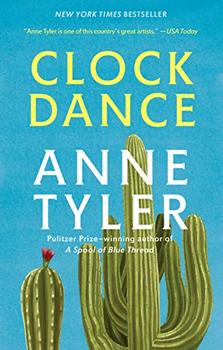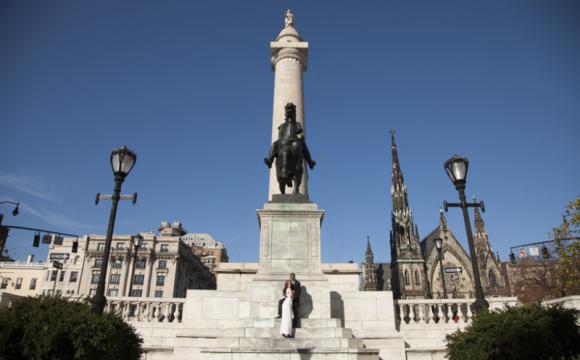Summary | Excerpt | Reading Guide | Reviews | Beyond the Book | Read-Alikes | Genres & Themes | Author Bio

Critics' Opinion:
Readers' Opinion:
First Published:
Jul 2018, 304 pages
Paperback:
Apr 2019, 304 pages
 Book Reviewed by:
Book Reviewed by:
BookBrowse First Impression Reviewers
Buy This Book
This article relates to Clock Dance
 Clock Dance, like many of Anne Tyler's novels, takes place in Baltimore, Maryland. The largest city in the state, Baltimore is home to over 600,000 residents, or 2.8 million people including the entire metro area. Located just 40 miles northeast of Washington, D.C. on the Patapsco River close to where it empties into the Chesapeake Bay, it is the second-largest seaport in the Mid-Atlantic region in terms of cargo transported (with Virginia's Port of Norfolk being the largest). The bay opens to the ocean via the 14-mile Chesapeake and Delaware Canal, and is a major automobile-shipping hub. It is one of the most naturally-protected harbors in the world; the Delmarva Peninsula shields it from most hurricanes, and the Appalachian Mountains to the south temper its climate, keeping the bay from freezing over in the winter.
Clock Dance, like many of Anne Tyler's novels, takes place in Baltimore, Maryland. The largest city in the state, Baltimore is home to over 600,000 residents, or 2.8 million people including the entire metro area. Located just 40 miles northeast of Washington, D.C. on the Patapsco River close to where it empties into the Chesapeake Bay, it is the second-largest seaport in the Mid-Atlantic region in terms of cargo transported (with Virginia's Port of Norfolk being the largest). The bay opens to the ocean via the 14-mile Chesapeake and Delaware Canal, and is a major automobile-shipping hub. It is one of the most naturally-protected harbors in the world; the Delmarva Peninsula shields it from most hurricanes, and the Appalachian Mountains to the south temper its climate, keeping the bay from freezing over in the winter.
The city was founded by British colonists in 1729, including George Calvert, titled Baron Baltimore (1579-1632), for whom it was named. After his death, Calvert's son Cecilius Calvert, Second Baron Baltimore (1605-1675) became Maryland's Proprietary Governor, though he managed its affairs from his home in North Yorkshire, England. Baltimore quickly became a shipping center for tobacco and grain, and the local waterways were used for milling grain into flour. By the outbreak of the American Revolution it had become a shipbuilding center; the U.S. Navy's first ship, the Constellation, was launched here in 1797.
During the War of 1812, a 35-year-old American lawyer named Francis Scott Key sailed across the Chesapeake Bay to the British ship HMS Minden to negotiate the exchange of prisoners. He was kept on board, however, as he'd overheard the enemy's plans to bombard nearby Fort McHenry, and was forced to watch during the night of 13-14 September (1814) as the British carried out their attack. The next morning, he found that the American flag still flew over the fort; the foe had been defeated. It inspired him to write a poem titled "Defense of Fort M'Henry," which was later set to music and became the lyrics to the country's national anthem.
Named "Monument City" by John Quincy Adams after his visit in 1827, Baltimore has long been known for its public statues and architecture. The first monument to George Washington, designed by Robert Mills, was erected here in 1829. Mills went on to design the Washington Monument in the nation's capital. It is believed that Baltimore has more statues and monuments per capita than any other city in the country.
Maryland remained a slave state throughout the Civil War, and although it fought on the Union side, Confederate sentiments were strong across the state. Baltimore, however, had long harbored escaped slaves; it was home to more free black citizens than any other city in Maryland, and was a major stop along the Underground Railroad.
A catastrophic fire razed the center of the city in 1904; more than 1,500 buildings burned in 30 hours. Amazingly, the city took only two years to recover, and by World War I it had become an industrial hub. The war saw additional construction of steelworks, oil refineries and other war-related industries, and this prosperity persisted through the end of World War II.
The post-war decades saw Baltimore become a victim of urban decay as a result of deindustrialization and economic blight. "Suburban flight" in the 1960s led to further decline. A massive urban renewal project began in 1979, however, which has rejuvenated the city's core and seen the return of commerce to the central business district. Johns Hopkins Hospital and Johns Hopkins University (named for the entrepreneur, abolitionist, and philanthropist whose endowments paid for their founding) are Baltimore's top two employers, and tourism also makes up a large portion of its economy (the National Aquarium is Maryland's largest tourist attraction). It is also home to the Pimlico Race Course (home of the Preakness Stakes), and professional sports teams the Orioles (baseball) and the Ravens (football).
Nevertheless, Baltimore has a long way to go before it recovers its former glory. Crime is far above the national average; it was named the most dangerous big city by USA Today in 2018 due to its high murder rate. In 2015 it had 344 homicides, the second-highest per capita in all U.S. cities behind St. Louis, and had the second highest number of opioid-related deaths (after Dayton, Ohio). Nearly 24% of residents live below the poverty line, compared with the 13.5% national average, and the median household income is significantly below that of the rest of the country.
Baltimore's Washington Monument, courtesy of Baltimore.org
by Kim Kovacs
Filed under Places, Cultures & Identities
![]() This "beyond the book article" relates to Clock Dance. It originally ran in August 2018 and has been updated for the
April 2019 paperback edition.
Go to magazine.
This "beyond the book article" relates to Clock Dance. It originally ran in August 2018 and has been updated for the
April 2019 paperback edition.
Go to magazine.





The Funeral Cryer by Wenyan Lu
Debut novelist Wenyan Lu brings us this witty yet profound story about one woman's midlife reawakening in contemporary rural China.
Your guide toexceptional books
BookBrowse seeks out and recommends the best in contemporary fiction and nonfiction—books that not only engage and entertain but also deepen our understanding of ourselves and the world around us.